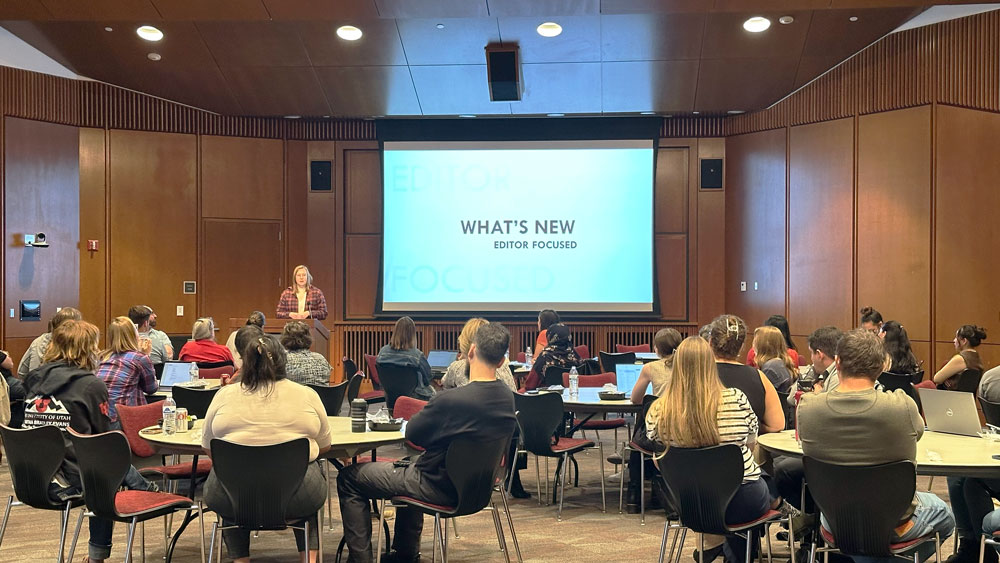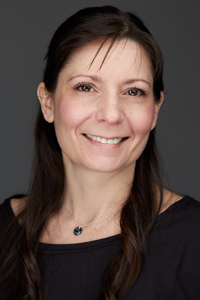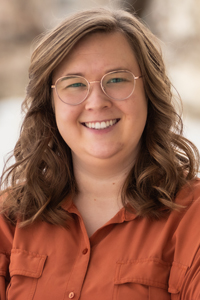Web Support & Usability team unveils new features, resources for Modern Campus CMS users at fall summit

Abbey Allen, at lectern, gives a presentation on what's new in Modern Campus CMS on October 15, 2024, in Gould Auditorium in Marriott Library.

Barb Iannucci, director, Web Support & Usability

Abbey Allen, web development and content support specialist, Web Support & Usability
At its annual fall summit, the Web Support & Usability (WSU) team in UIT University Support Services (USS) unveiled new features, training modules, and an online forum for Modern Campus CMS users; updates to FontAwesome icons; and ways to leverage artificial intelligence (AI) for web content development and production.
WSU Director Barb Iannucci also provided updates on Title II of the Americans with Disabilities Act (ADA). For more information on the changes, please access this Node 4 article.
The event, held October 15, 2024, in Marriott Library’s Gould Auditorium, kicked into high gear when Iannucci and Web Development and Content Support Specialist Abbey Allen announced all things new and updated for Modern Campus CMS editors.
- Database-driven faculty and staff directory — “Previously, people created their directories manually, and we saw a lot of inefficiencies. It was really cumbersome. So, we designed a database application that we can activate for your site, where you can enter data in a simple online interface, and the system will create your directories automatically. This approach offers a streamlined way to manage data,”
- Updated Modern Campus CMS training, now in Canvas — “We believe that by setting a high standard for our editor training, we’ll be able to maintain excellent digital content across the university. We encourage everyone, even if they’ve already taken the Bridge training, to take this new one,” Allen said.
- New and updated page layouts in the Design Library — “We noticed a lot of people want to use these layouts ... so we made a way that you can download the templates and upload them to Modern Campus. Images will be broken — you’ll need to replace those — and you’ll have to replace the dummy text. ... We also recently uploaded eight additional templates, six generic pages and two main landing pages,” she said.
- Updated Modern Campus CMS guides — “We recently reviewed all our guides to ensure they are still relevant, answer
your common questions, and include the most recent updates from Modern Campus CMS.
We also included information on new features, such as archiving pages, which is an
alternative to recycling; embedding and formatting images; overriding pages; and updating
navigation items,” Allen said.
- Coming soon: video walkthroughs — “We’re going to start recording and rolling out video walkthroughs to help people who learn better visually,” she said.
- Updated FontAwesome icons — “We more closely aligned our component, with FontAwesome’s icon families (e.g., classic, duotone, sharp) and icon styles (e.g., sizing, colors). We included all sizes and university brand colors. ... One thing to note, previously placed icons will continue to work with the updated component. There’s no need to change anything, unless you want the updated features. Then you’ll need to delete the old icon (not edit) and create a new one,” Allen said.
- New forum, Bits & Bytes — “This will be an open forum. Someone will be there for an hour, probably me, and we’re going to answer your questions. The first portion will cover a specific topic ... like features related to Modern Campus, accessibility or updates we’ve recently done. If you have a topic that you’re interested in learning about or kind of confused about, you can submit ideas and we will roll them into our forums. ... We want to build a collaborative environment where we can all become more confident in our web editing abilities together,” she said.
-
- First Tuesday of the month, 10:00 a.m.
- Third Thursday of the month, 2:00 p.m.
- For more information, including the meeting request link and topic submission form, please visit the Bits & Bytes page.
Allen also provided an overview of the checklist her team uses during site reviews to ensure webpages are accessible.
“This list helps us check the page for keywords and descriptions, verify that nothing is broken on the page, and catch any spelling issues or accessibility errors in final published checks,” she said.
- Page description — Helps search engines understand your content and improve your page’s/site’s visibility in search results. Descriptions should be clear and concise.
- Page keywords — Helps search engines understand your content and improve your page’s/site’s visibility in search results.
- Broken images and links — Ensures that your links go where they say they go. For images, descriptive alt text that provides context is important for people who use screen readers. For links, descriptive text that provides context is better than “Click here” for people who use screen readers.
- Publish-Final Check — Shows errors for spelling, broken links, W3C validity, and accessibility. WSU recommends selecting the button that says, “Run all checks.”
- WAVE tool (browser extension) — Checks published pages for accessibility issues, including color contrast errors, heading structure, and navigation order.
Iannucci then shared how her team uses approved AI tools like the university’s instance of Microsoft Copilot to help with web content development and production.
- Draft content — AI tools can generate outlines for webpages, blog posts, and event announcements.
- Edit and proofread content — AI tools can suggest grammar, punctuation, and readability improvements.
- Optimize content for search engines — AI tools can help identify keywords and write meta descriptions.
- Personalize content — AI tools can analyze user behavior and preferences, and make recommendations.
- Generate ideas — AI tools can provide suggestions for new topics based on trends and help you keep your content fresh and relevant.
- Accessibility — AI tools can help ensure your content is accessible by suggesting appropriate alt text and more.
Although Iannucci said AI tools can enhance productivity, she stressed that they are not a replacement for humans.
“The content AI tools generate can often feel mechanical or robotic. So, it’s important that you go back through what AI gives you, and finesse it and humanize it. ... AI tools lack the depth of human reasoning, they cannot replicate human insight or judgment as a writer,” she said.
Iannucci ended the summit with a reminder of the resources available to web editors and a Q&A session, in which a few head-scratchers came up. The WSU team stayed afterward to assist, using the rare opportunity to help their customers in person.
“Our team is here to help everyone in this room be successful in their jobs and make their university websites engaging and user friendly,” Iannucci said.
Node 4
Our monthly newsletter includes news from UIT and other campus/ University of Utah Health IT organizations, features about UIT employees, IT governance news, and various announcements and updates.
